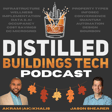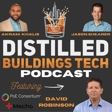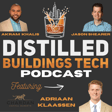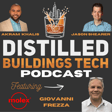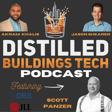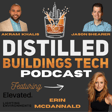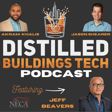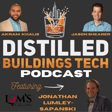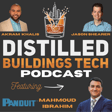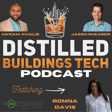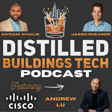Introduction and Guest Welcome
00:00:19
Speaker
Welcome everybody to the Distilled Buildings Tech Podcast. Where smart buildings are stirred, shaken, and data-driven. Awesome, I'm your host, Jason Scheer. i'm your host, hey ky And with us today, we have Olivier from Electricity Maps. Olivier, welcome to the show.
00:00:36
Speaker
Thank you, pleasure to be here. Yeah, excellent.
Olivier's Background in Energy and Data
00:00:38
Speaker
and This is a conversation I've been looking forward to for um for a really, really long time, having been an Electricity Maps fan, for a fanboy for for ah for ah quite a while.
00:00:49
Speaker
um Can you tell us just like a little bit about your you know your history, like education, like how you got to where you are today? Yeah, sure. So I'm originally, I studied applied mathematics.
00:01:02
Speaker
ah Basically, was just always super, super interested in how computers could leverage math in order to create magic in the world. And I studied math. I went into machine learning afterwards.
00:01:14
Speaker
And for me, energy was always the space where you have real-time data. Everything is real-time, especially with so many renewables coming onto the grid. And this was just a perfect way to apply my skills.
00:01:25
Speaker
And i wanted to play at the intersection between IT and energy. I ended up studying applied statistics afterwards in my master's, tried to apply these things together with IBM Research, where I spent a bit of time.
00:01:40
Speaker
I did a lot of research on how you could simulate vast electricity grids under like a very high penetration of renewables. um i don't know how nerd you want to get about this, but spend a bit of time doing control systems as well. We both engineer have engineering backgrounds, so we can totally geek out. yeahp yeahp so so i did So basically my master thesis was about how you could use a control system that would generate electricity prices in order to get the desired amount of load on electricity grid. So basically, say let's remove markets. And it's i imagine instead a machine that generates the right prices to get the right
00:02:14
Speaker
response. um And it was fascinating. And I spent a bit of time there, spent a bit of time at um IBM Research, as I mentioned, simulating these grids. And IBM was great, but it was still like a very, very big, you know, old engine, so to speak.
00:02:30
Speaker
um So I went into Google instead and worked on Google Maps over there, little bit on energy stuff as well. And at some point I just realized the amount of responsibility right now that I'm given is insufficient compared to the hunger that I have to just create stuff.
00:02:46
Speaker
And so I left there, joined the early stage startup in Paris. we were building AI systems that would run on your device, little bit like trying to replicate Siri, ah but running on the device.
00:02:57
Speaker
Well, I learned a ton of computer science stuff and math and ML, but didn't really work in this energy space anymore. And after that, I left. And this is almost 10 years ago that I left.
Founding of Tomorrow and Evolution into Electricity Maps
00:03:10
Speaker
And I wanted to get back into ah you know energy and intersect that with data. And then I started looking much more at climate change, read everything I could, IPCC reports.
00:03:22
Speaker
And I realized, oh my gosh, like no one is talking about this. And this is massive. And this was before you know loads of people were talking about climate. And I said, I must try to distill everything that I know and get all these tech folks that I've been hanging out with you know, to understand how big this of an issue with this is.
00:03:40
Speaker
And so I founded a company that was called Tomorrow that was really put into the world to build the Google of sustainability because I had this thesis that information about climate change was very difficult to digest.
00:03:54
Speaker
And if you could do what Google search had done to the web, but do that for climate, make information accessible and widely useful, then you know that's a super scalable way to start tackling the issue. If you have people building products based on information, then you it's pretty impactful.
00:04:08
Speaker
And build a couple of prototypes, different products. And we can talk about the other products if we're interested. But electricity maps was one of the first thing that I built there. And you know a couple of years down the line, renamed the company from Tomorrow to Electricity Maps um and then it grew
Growth and Partnerships of Electricity Maps
00:04:23
Speaker
and grew and grew. And now it's, what is it? What are we like? Almost 40 people based out of Copenhagen in Europe ah building this and working with some of the you know biggest companies in the world, like the Cisco's, the Google's and to Microsoft and so on.
00:04:36
Speaker
thats that's That's quite the quite the journey and ah in a relatively short period of time. um being Being in you know Denmark, I think one of the most you know one of the highest rated renewable energy like producers in the world, did that have um did that have like an influence on on the interest around energy and and carbon intensity?
00:04:58
Speaker
Yeah, absolutely. So during my studies, the professors I was working with, I basically asked them, have any cool research projects I can i can work on? And a lot of the research projects they had, which involved time series information and real time data, were all about wind power forecasting, because it was one of the first countries to experience what it means to have that much renewable in the system.
00:05:20
Speaker
And you need to be able to forecast it in order to be able to balance the grid and reduce the need for fossil fuels. And for me, forecasting was kind of this thing where It's a bit magical. You put in a bunch of you know zeros and ones and data, and then some algorithm will be an oracle and spit some information about the future. Like how the heck does that work? So I was always fascinated by that.
00:05:40
Speaker
and And this is where I applied But the funny thing is, um have a you know I'm born and raised in France. my so have my My father is French, my my mother is Danish, and I've always been in in both countries.
00:05:54
Speaker
And interesting piece is that Denmark is a highly renewable country. And then you have France, which is exactly the opposite, sort of hate renewables, always been like heavy nuclear. Most of the electricity is nuclear in France.
00:06:05
Speaker
And so I've always been in this like you know, in these two worlds. Kind of between worlds. Exactly. Yeah. and And in between a lot of debates that actually has happened with electricity maps and, you know, should should the world be 100% nuclear or should you be 100% renewables?
00:06:16
Speaker
And I'm like, guess what? The answer is a little bit of both, but both yeah yeah yeah. Awesome. That's cool. So as the audience know us, so next drink that or choice of drinks that Olivier came up with is little bit complex than what they they're probably going to see in the past episodes. So why don't you tell us what your favorite drinks was?
00:06:36
Speaker
It's actually a whiskey sour. And I'm happy that I'm, you know, bringing the bar up as we were mentioning earlier. But yeah, I really, really like this combination of sort of the, you know, this sour piece and more of the bourbon together with a bit of egg white, which creates this this nice foam at the top. you know, it's perfect.
00:06:53
Speaker
Yeah. That's awesome. Awesome. Cheers them. Cheers. Cheers, guys.
00:07:00
Speaker
Do you have... um Do you have a specific bourbon that you like mixing into your whiskey sour, Olivia? I'm not that fancy. i should not that fancy i'm not i'm not I'm not at that level yet.
00:07:10
Speaker
yeah um i yeah But I should probably at some point, if I'm being honest. You did get the foam right, though. It might have looked little bit diluted. And yours looked like there's that thickness of foam up there. Yeah, got to really shake it really well. And then at the end, the foam is going to be at the bottom. So you're going to really, really continue pouring it, even though you think there's nothing coming out. The foam is the last thing to come out.
00:07:36
Speaker
my My wife and I have been experimenting with like a a lot of egg white cocktails over the past couple of months. And the hack or the trick that we have found is the dry shake. So like shaking it with no ice and, you know, for a while and that kind of like develops the foam and then putting ice in it and shaking it a little bit more and that like chills it.
00:07:55
Speaker
um So, yeah, there's there's definitely tricks to to getting like that nice, you know, foam layer at the top. That's a good And do you add the the sweetness over the cherry? do you stay away from that?
00:08:05
Speaker
What's the combination? So actually like putting a little bit of sweetness and including like a cherry if you can. i didn't have any with me right now, but but else I would have definitely. So yeah, I saw you guys have it. Yeah, you're really pulling it off.
00:08:18
Speaker
Just follow the recipe, yes. That's a good way to do it. Great.
Role of Electricity Maps in Smart Energy Use
00:08:24
Speaker
And it from your inspiration of Electricity Map, maybe tell the audience, just in moment,
00:08:30
Speaker
that From a thousand foot up, yeah what what is Electricity Map at all? What does it do? What's what's the services that it offers and what's the product? Yeah, so really the the place where it started was to say, you know, the world is moving towards more renewables on the grid. So we got look in real time at where electricity comes from.
00:08:46
Speaker
Really, the the starting point for all of this was I was reading the news and I saw this news that Denmark had ran 100% renewable electricity for a day. it was like, oh, ah really? OK, so what about, you know, yesterday and tomorrow? whats what What does that number look like?
00:09:01
Speaker
And so started gathering a bunch of data, created a data visualization that just showed this in real time. And then afterwards, it really started to take more of a life of of its own, realized that this can be leveraged ah in order to tell all flexible devices across the world, whether it's ah you know a dishwasher,
00:09:20
Speaker
washing machine, an electric vehicle, a data center, heating systems. What is the optimal time to use electricity to make sure that you use at electricity when it's when it's clean and not when the dirty fossil fuel so power plants are running?
00:09:34
Speaker
And so you know where we are now is we've moved far beyond just this nice data visualization that we had originally. Now it's this comprehensive data platform which provides all of the electricity grid signals that you need if you want to build any core use case on top that you know that interacts with the electricity grid.
00:09:53
Speaker
A simple way to think about this is if you pick any location on the globe, then we'll tell you in real time everything there is to know about the electricity system, you know where electricity comes from, how it's generated, ah electricity flows, the electricity prices, how much carbon is emitted, how much renewable is present.
00:10:11
Speaker
And we're doing that historically. And it's typically if you want to do it like carbon accounting, then you need historical data. Real-time that powers quite a few interfaces. you know There's apps out there that are leveraging our data.
00:10:23
Speaker
And then the predictive piece, like predictions up to you know a week ahead is our ambition. Right now, we're only at a couple of days, but pretty soon going to be at the week ahead. And this enables smart scheduling. As I mentioned, these dishwashers, you know you go home, you press a button, it just dumbly runs immediately.
00:10:40
Speaker
What if it knew that in two hours would be a good time to run because it could save you money and it could save a little bit of carbon because a power plant is not going to have to you know burn some fossil fuels as a consequence.
00:10:51
Speaker
So it's a data platform. That's really the ambition and to give you all the electricity signals required to build any co-use case on top. Cool. So it's really like when you go to electricity maps, like the first thing you see is a like a beautiful, like reactive interface. But the real power is leveraging like the API to to take that data and um and and synthesize or correlate that against like other data sets that a customer might have.
00:11:20
Speaker
Yeah, absolutely. you know Another way to look at this is that we're trying to build the Google Maps of electricity. You have like this emerged tip of the iceberg, which is the physical world that we're trying to represent. um you know pretty Pretty soon on electricity maps, you're going to be able to see, for example, the location on of the big data centers.
00:11:38
Speaker
So it's really trying to be this Google Maps where you can visualize anything that interacts with the electricity grid. And underneath the maps are this powerful engine, the data layer, and that we're making it accessible for other companies who want to build use cases on top, like smart dishwashers, smart data centers, whatnot.
00:11:57
Speaker
You mentioned both aspects, interior, inside the building and outside the building. So is the vision to what's the vision for the next year inside the building and what's the vision outside of the building?
00:12:09
Speaker
When you look at the electricity, there's a consumed electricity inside and then you have obviously the power plant sharing power between each other. Is electricity bridging those two
Global API and Community Contributions
00:12:18
Speaker
together? Is the vision to do that?
00:12:20
Speaker
Well, I think what we do is that we want to represent as accurately as possible what's happening on the electricity grid and make sure that the orchestration between, let's just say, like outside of the home, inside the home or inside the building works as well as possible.
00:12:35
Speaker
And that really means two things. It means one, providing the right signals so all the devices are making the right decisions. And if you want to do that accurately, you need to have like a very, very detailed picture of what the electricity grid looks looks like.
00:12:47
Speaker
And for the past couple of years, we've really been focusing on carbon emissions, focusing on the emissions of the grid, helping all these devices utilize electricity to maximize you know the emissions reduction possible.
00:12:59
Speaker
And what is going to happen in the next you know year and couple of years is that we're expanding really to give other signals. such as the electricity price. I mean, who doesn't want to tell a good story about, you know, I was able to reduce my electricity bill and I helped the environment at the same time.
00:13:16
Speaker
No one says no to that, right? It's a perfect story. yeah The second piece as well that comes after sort of can we help the grid operate more efficiently? So stuff like grid alerts, there's a couple of periods, know, times during the year where a grid operator will have its electricity grid reaching sort of maximum capacity.
00:13:35
Speaker
For example, all their air conditioning system is going to be turned on because it's like the hottest day of the year. And that's the worst time of the year to be using electricity. So if we can make it simpler for everyone as a citizen, as a company to see these events, predict them, then you're going to help the grid as well.
00:13:52
Speaker
So grid alerts is also a piece of that, of the picture that we want to try and to put in. And if we manage to do that, it's already like a pretty big you know effort, especially since we're trying to do that globally.
00:14:03
Speaker
And that's really the big feat here is to be able to do that on a global scale, one API for the for the world. That's really the hard thing. That's fascinating because we talk about interoperabilities and smart buildings and and our our challenges, you know Jason and I, is is really to focus on customers' journey when they're when they're looking at global expansion. you know our Our journey is all on Ethernet, which is a global adopted. And kudos to you trying to do that globally.
00:14:29
Speaker
and ah How do you manage you know creating that global API around the world, given obviously you have language challenges, culture challenges, I know the dollar is the same, right? it's all Currency is the same. Somehow or another, where you pay for energy, right?
00:14:46
Speaker
Absolutely. Well, maybe the the honest answer is we we didn't even try to do it ourselves because we knew it it was it would be impossible. So something that worked really well in the early days of electricity maps is that only a couple of countries had actually a color on the map, meaning we have data for that particular region or area.
00:15:04
Speaker
And it was a call to action when you were hovering over an area where there wasn't data. Basically said, if you know where data is available or if you're a coder and you can help us build the integration, then click here and it would take you to GitHub.
00:15:20
Speaker
And we'd had these guidelines of... Here's how you can build a very simple Python script that will connect to wherever place contains the data we're looking for. Here's how to format it in the output so we can understand it in a standardized way.
00:15:35
Speaker
And then as soon as you do that, we'll digest it. i mean, of course, we'll we'll re review the code first, but then we'll we'll ingest that data and it will appear as a new color on the map. So the bottom line is by by having open sourced the data integration side of things,
00:15:50
Speaker
And by having an app where the call to action was extremely clear, the you know contribution pathway was relatively simple, then it just meant that we had you know some Indian folks that were helping us put Indian on the map.
00:16:03
Speaker
um I remember reviewing a pull request with some Korean data. And I tell you, I have no idea how to read Korean. korean you know we we had someone who did that for us.
00:16:15
Speaker
um And then one day someone had built a translation system for the app as well because they just wanted it in their own language to be able to showcase it to friends. And then people started to contribute with translations.
00:16:26
Speaker
And then you get this snowball effect of the flywheel starting to turn. So the the community approach can be extremely powerful if you give some clear rewards and a simple pathway to contribute.
Challenges in Data Validation and Anomalies
00:16:39
Speaker
Because you know we there's a lot of folks in the tech world who have a bit of spare time, who want to help out a cool project, but it needs to be time boxed, it needs to be simple. And it turns out that lots of people work in the power system industry. So you could just if we could just touch them, then they would be happy to contribute, right?
00:16:57
Speaker
sure What has been the so so thinking about this from like a big data problem, right? And and leveraging open source and community to contribute different data sources. What's been the biggest challenge around, you know, validation and normalization of that of that data?
00:17:16
Speaker
I guess one piece of it is the you know having clear definitions. One example is biomass is something that depending on which country you're looking at, they will all have different definitions. In some countries, it's it includes, for example, burning waste.
00:17:32
Speaker
What do you qualify as waste and so on and so forth. So so having this like simple yet precise definition of what goes into each category um is definitely one challenge.
00:17:44
Speaker
The other is it's pretty it's more difficult than it appears to have clear definitions of what constitutes a data point that can be trusted. and It turns out that you have data providers like grid operators who always apply a certain amount of modeling or estimation to the data that they're producing, even if it's just a tiny bit, and they will apply some modeling. And on the other side of the spectrum, you can have data that's like completely estimated, like a model that's just running out there, estimating based on weather data, what they think the production is.
00:18:15
Speaker
Where do you draw the line of what's trustworthy for us to bring inside our system? And then afterwards, this is not static. It changes over time, meaning that from one day to the other, suddenly you have a data provider that's only going to report half of the wind produced because suddenly this lost telemetry to you know half of the wind turbines.
00:18:36
Speaker
How do we, from our perspective, differentiate between a situation where um you know there's not that much wind production and a situation where only half of it is reported?
00:18:47
Speaker
And so you need to, little by little, start of building more intelligence into the platform to make sure that we can be smarter about detecting what is a wrong situation and what is an actual data problem and what is just ah an anomaly from the power system and that we actually want to cover.
00:19:05
Speaker
I have a great example actually of something that just happened in Europe not too long ago with with the you know the Spanish electricity grid. i was had i had I had that on my left. I was like, we have to talk about Spain.
00:19:16
Speaker
Let's talk about Spain then. i So, you know, the the grid the grid went down. And um and in the beginning, for for a couple of you know minutes, I think for 15 minutes or something like that, our systems and genuinely believed this was a data problem.
00:19:29
Speaker
You know, it it it it possibly cannot be that everything went to zero. So it must be a data problem. And then our systems started to generate data. um artificial data in order to you know make up for the fact that node that the data wasn't trusted, so it's taking over.
00:19:46
Speaker
um And then very quickly we realized, oh wait, this you know this is an actual outage. Let's very, very quickly intervene here and to make sure that we're letting like the real data go through. And now we have, you know we've built another layer of of different anomaly to section models that they are going to be able to detect these kind of things. But the point is, it's it's very difficult at scale completely automatically to have a system um that can assess you know assign a certain trust value to a data point.
00:20:14
Speaker
and Because down the line, our customers, they're paying us to have like a single API globally trusted across the world. And sometimes we make mistakes, right? This was an example. Then we have to learn from it and build a better system afterwards.
Product Offerings: API and Free Tools
00:20:27
Speaker
that's That's a great model. And and for the for the audience that doesn't understand, how does Electricity Map, Olivier, transacts? What's the business model? Is it API driven, consume API, or just what's the business model look like?
00:20:41
Speaker
Yeah, so so as we mentioned before, there's the emerge tip of the iceberg, the visualization, that's completely free to everyone because we don't want to put any barriers to how information you know flows in the world.
00:20:52
Speaker
But the API itself, this is a paid product that we have. and Large customers are buying this as a subscription model. They pay us a fixed fee on a yearly basis, typically, then they get access to the API and that they're able to use it in order to build other use cases on top of what they're doing.
00:21:10
Speaker
um So that's typically the way that we work. But we are considering actually having a different set of products um that are not only the API that could be monetized as well, because we just realized there's so much ah so much potential behind what we're doing, actually.
00:21:24
Speaker
Totally. I mean, if once you get into the the regional and then you get to the smart cities of the world, that sharing that information across buildings, it's it's fantastic. it's It's actually what we but we always dreamed about, where the building next door can actually leverage or understand what the building next to it is doing in the cities and it trickles down in countries and you're doing it on global scale, which is really, really exciting.
00:21:51
Speaker
had it from from ah And that that really that was one thing I was thinking about, AK, a lot of the data that's contributed to electricity maps is probably like municipal um generation, right? Like commercial generation of electricity and consumption of electricity, Olivier.
00:22:08
Speaker
Like how do you... How do we take it a step further? And for, um you know, for for either individuals or companies that are doing their own like on site generation, um is there a way to kind of like insert that into the into the data lake to be reported on?
00:22:27
Speaker
Yeah, so the the you know as a startup, one of the trickiest thing to do is always to say no to things and to focus on one particular thing. and So something that we decided pretty early on was to say, we're not looking at what happens ah you know in your home behind the meter.
00:22:43
Speaker
We're only reporting the grid's perspective. And that means that if you have a data center and you have some you know local generators, you will need to add another layer to our data, which is, you know our data is is applicable when you're consuming from the grid.
00:22:58
Speaker
If you're consuming from your local systems, then you've got to set up your own system for that. um But it's ah it's a step that I'm always dreaming of taking in the future. Some of the things we're starting to look at is is you know mapping out all of the assets in the world, um because there is a lot of open information out there about where all the assets are, and many of them are behind the meter.
00:23:21
Speaker
And it would be a shame not to represent that as well.
Future Goals and City-Level Data
00:23:23
Speaker
There are some countries that have ah very large amount of renewable generation, which is behind the meter and which is not necessarily mapped on electricity maps because it doesn't directly sort feed into the grid.
00:23:35
Speaker
and That's a shame to not being able to map it out. Right. Yeah, i see I see smart energy in in the building space where we are. so you know traditionally, you you had no idea as a building owner each an individual consumption. You just know that you had meter running and you get the total consumption and then you could yeah times the KWH price and then you have to pay that bill.
00:23:57
Speaker
Now in an intelligent space, you have physically separations between each individual endpoint and you can actually measure it. um If that information can flow back into electricity map and now you can do it at scale, meaning in multiple headquarters, multiple companies, and you can normalize it by customer, then you can cross-check against what you're actually consuming.
00:24:19
Speaker
that That gives you that level of reality that you probably wouldn't have before. And that's really what gets me excited about the future as well, is that I think we're still scratching the surface on what's possible here. If you think about about it on electricity maps, what you have is a pretty, you know, we have we have the geographical coverage or sorry, the geographical resolution of the data is is not hyper, hyper granular. We could go so much further.
00:24:42
Speaker
ah we We are not looking at the city level. We're not looking at the street level. This is something that you know the the the system would easily scale to that.
00:24:52
Speaker
The data is really the limitation there. We don't have telemetry data at that particular level level where it's not real time. And we are always thinking internally whether or not we should try to bridge that gap with some of the models that could help us estimate. you know There are come some interesting research publications that looked at a whole region and looked at the flows of electricity outside and inside this region, looked at the amount of production there is in the whole region.
00:25:21
Speaker
And if you start knowing the topology of the network inside that region, you know exactly which wind turbine is generating what. Then you can start to estimate pretty well you know what the flows look like inside this region and how much of the wind energy actually makes it into your own home versus you know um another location, which is maybe a couple of miles away or something like that.
00:25:41
Speaker
It would require a different level of computation and we have to make sure the methodology is right and so on. But I see that as part of the future steps that we'll inevitably will be able to take as more data gets published.
00:25:56
Speaker
Yeah. And like one thing I wrote down was like, like early warning system and like predictive, you know, failure analytics, um, like, um, you know, imagining a world where, whether it's a, you know, a producer or a consumer has that forecasted data and they know whether or not they need to bring on, you know, supplemental gas turbines because it's going to be a cloudy day or like a low wind day. Are are you seeing use cases where, where producers are using that data to make those decisions?
00:26:24
Speaker
So we are starting to get into the predictive realm more and more, and we're starting to work with with producers and that are interested in this information exactly for the you know the use case that you described. um I think the the thing that we're trying to do, because there's many folks that are do that already pretty well, to be honest, they do that at local scales.
00:26:43
Speaker
But i think what no one has been able to do is to take that at a really global scale. and And that requires us to build systems that are scalable from day one. Like if it doesn't work in all the different regions at all the different you know levels of quality of input of the data that we're going to get in, then we're not doing it.
00:27:03
Speaker
And I think that being able to work on higher spatial granularity globally is something we want to do. it's it's not It's still not completely doable right now, but I definitely foresee a future where you will, for example, be able to live stream information about a particular plant in one location, which is receiving you know a cloud over it and therefore can produce solar electricity.
00:27:25
Speaker
And we know the direction of that cloud and maybe a couple of minutes later, it's going to be next to a different plant. And then you have like one of the best forecasts if you can put everything in the same platform. So really this game of, can you centralize all of the data?
00:27:38
Speaker
Can you start building synergies from them? And this is really where it starts to become exciting.
Regulations and Open Data in Energy
00:27:44
Speaker
Is there regulatory challenges or landscape that you have to navigate when you're talking about a global scale?
00:27:51
Speaker
you i I think of the US and i I just can't overcome the the regulations of just between, you know i um i live in Jersey and our office is in New York and just those two cities, you have so much to go through.
00:28:04
Speaker
How does that apply to you? Yeah, we've been actually lucky on that side because the regulatory landscape has helped it helped us a lot by creating a legal framework that, let's say, motivates or creates a framework for for data providers to actually publish this information so we don't have to and do the heavy lifting of of going to someone, convincing them that they need to open up the data, make sure that you know there's no compliance risk or security risk to that data and then get access to it.
00:28:38
Speaker
So most of the information we get is actually open data um or it's data that that you know we're collaborating with customers. But in some sense, the regulatory landscape has really helped us because it's it's pushed regulators to open up more of the data.
00:28:51
Speaker
We've seen that, especially in Europe. there's a There's an energy directive in Europe that mandates that every country has to publish in real time a certain list of signals from the electricity grid.
00:29:01
Speaker
And the newest directive is just pushing that to a different level, providing you know access to smart meter and interoperability and so on. And I foresee that we'll just continue to go that route because... A power grid is a shared asset paid by, you know, a lot of the taxpayers in the end.
00:29:17
Speaker
and So if you can create a system that rewards more innovation, lowers the price for everyone, and what better way to foster innovation than put data out there and let people build, you know, cool new technology on top of it.
00:29:29
Speaker
Yeah. And that kind of goes back to, you know, kind of the roots from an open source standpoint and thinking about, you know, like crossing geopolitical boundaries, like you guys almost make yourselves a, like a Switzerland of like the source of true data.
00:29:46
Speaker
I like that. Yeah. That is awesome.
00:29:51
Speaker
That's that this fascinating.
Vision for Smart Cities and Renewable Integration
00:29:53
Speaker
Imagine a world, an ideal smart city or smart smart globe. How does Electricity Map want to be in it? Or what do you see Electricity Map playing in?
00:30:03
Speaker
Yeah, the vision the division that I've had actually since since i i so I studied energy was really to have, i mean, just imagine for a second, if you look at all the devices or systems in the world that have and little bit of flexibility and basically change the time at which to use electricity.
00:30:19
Speaker
I want all of these devices to help the grid decarbonize faster by utilizing renewables when they're available. And that's really the the end goal, I think, because you know it's easy to decarbonize a grid with with renewables in you know until you get to 60%, 70% renewables, because you can just add more renewables on a grid. But the last 30% thirty percent that's super difficult because you need all these backup systems to be there for the rare times where there's going to be no wind and no solar.
00:30:49
Speaker
and And this is where the smart city promise comes into play. like You want this energy grid to start sending like or to collaborate with all the devices in buildings, in homes.
00:31:03
Speaker
And we did a study back then were heating in buildings, if they were operated in a smart way, they could reduce by 20% your emissions and your electricity bill.
00:31:15
Speaker
Think about how much of it is currently not instrumented in that way. That represents a massive untapped opportunity. And the only thing we need to do is connect these systems to the Internet, almost want to say, right? We don't need to do much more.
00:31:28
Speaker
CapEx is very limited. these things You don't need to spend a lot of money. So for me, the promise is really this flexibility piece. Everyone has been talking about it, but I haven't yet seen it deployed on a large scale.
00:31:40
Speaker
And I think we're starting to see the you know the first signs that it's starting to get deployed. And especially with the AI wave that's exploding. i think we're going to see much more of it in the next couple of years.
00:31:52
Speaker
Absolutely. When you think about, you know, on-site storage, like we see a lot of customers, particularly customers that have um like a tiered rate schedule from their utility company, you know, putting on-site storage in place so that they can do rate trimming.
00:32:06
Speaker
um And then they're, you know, they're filling that, that on-site storage backup from the grid at either low rate or low carbon intensity times. um But having, having that data to be able to make those decisions is, is the probably the most important thing.
00:32:22
Speaker
going to need the data and you're going to need like the you know the prediction models and the optimization algorithms afterwards. right So it starts with data, then you have predictive capabilities and they have optimization capabilities afterwards. And you need these three things to work together if you want to pull things off.
Energy Storage and DC Infrastructure
00:32:36
Speaker
But it's very, very impressive to watch the uptake of storage in the past couple of years.
00:32:44
Speaker
Absolutely impressive. and And I got to tell you, it is truly the ESS systems, energy storage systems are are skyrocketing. We're seeing customers. I mean, the the DC infrastructure being the future is a no brainer and a lot of, a lot of,
00:33:01
Speaker
buildings that we see because of its just the nature of having the data and and and power all in the same bus. And all our devices are already DC natively built. Why not just store the energy DC?
00:33:12
Speaker
You harvest it in that that fashion anyway and deliver it in that fashion. There's no reason for conversion because you lose you know the efficiency and you lose a lot of it just by doing the conversions. And I think that intelligence between when can i use the energy and what time and the ability to know that at real time, it's massive.
00:33:30
Speaker
It's huge when it comes to absolute to delivery.
Personal Experiences with Electricity Maps
00:33:35
Speaker
Cool. Well, ah Olivier, this is this has been um this has been a really awesome conversation. Like I said, I've been i've been looking forward to it both from a personal side because I'm a home automation nerd and that I first found out about Electricity Maps like through the the Home Assistant integration to be able to tell myself, like what the carbon intensity of the the energy that I'm using.
00:33:56
Speaker
um And that's given me the ability to go out and have that same conversation with with customers. So what's what's what's the best way for, um you know, whether it's a customer that's listening or maybe another manufacturer or ISV, like what's the best way for them to find out about ah electricity maps and the capabilities that you guys have?
00:34:17
Speaker
yeah think the easiest is probably to go check out our website and check out our products. And when I say products plural, it's because the you know the map that we've been talking about is certainly one one place to get little bit more acquainted with exactly what type of data we have.
00:34:31
Speaker
But we actually have freely downloadable data sets as well that you can download if you want to just build a small prototype. And Home Assistant is definitely one of the shout outs, one of the best open source projects that I've seen around where and you're not the first one to ah to hack around in their home and use electricity maps for that. But this is also the kind of use case that want to be able to empower.
00:34:51
Speaker
Yeah, no, awesome.
Social Media and Data Sharing
00:34:52
Speaker
the ah The other thing I'd recommend for folks to do is um like follow Electricity Maps on Twitter. like That was actually how I learned about the Spanish ah outage a couple you know a couple of months ago was um was you and the and the team posting your data on Twitter around around that outage.
00:35:11
Speaker
Absolutely. We try to engage as much as we can on on on social media. well You wouldn't believe the amount of interesting stuff that happens globally on electricity grids. And I think at some point we should try to have a stronger social media prince to tell more of these stories. This one was too big to miss. So, you know, we we had to tell something about it.
00:35:26
Speaker
Awesome. Well, folks that listen to us as usual, like, and subscribe. And and and really it's a pleasure to to to talk to you, Olivier. and I think it's ah it's a it' an interesting so topic and it's really great product.
00:35:42
Speaker
Well, thank you so much. i appreciate the support.

